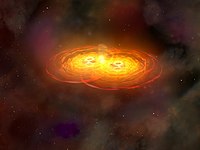
Photo from wikipedia
We study the general time dependence of complexity for holographic states dual to Lovelock black holes using the “complexity equals action” proposal. We observe that at early times, the critical… Click to show full abstract
We study the general time dependence of complexity for holographic states dual to Lovelock black holes using the “complexity equals action” proposal. We observe that at early times, the critical time at which the complexity begins to increase is a decreasing function of the higher order coupling constants, which implies that the complexity evolves faster than that of Schwarzschild black holes. At late times, the rate of change of complexity is essentially determined by the generalized Gibbons-Hawking-York boundary term evaluated at the future singularity. In particular, its ratio to black hole mass is a characteristic constant, independent of the higher order couplings. Thus, in the vanishing coupling limit, the result in general does not reduce to that of Schwarzschild black holes, in spite of that the metric reduces to the latter as well as the gravitational action. In fact, the two differ by a constant during the whole time evolution. Including the next-to-leading order term around late times, we find that as the Einstein case, the late time limit is always approached from above, thus violating any conjectured upper bound given by the late time result. For charged Lovelock black holes, we find that with sufficient charge, the complexity roughly behaves the same as the Einstein case. However, for smaller charges, the two have some significant differences. In particular, unlike the Einstein case, in the uncharged limit the complexity growth rate does not match with the neutral case, differing by a constant in the whole time evolution.
Journal Title: Physical Review D
Year Published: 2019
Link to full text (if available)
Share on Social Media: Sign Up to like & get
recommendations!